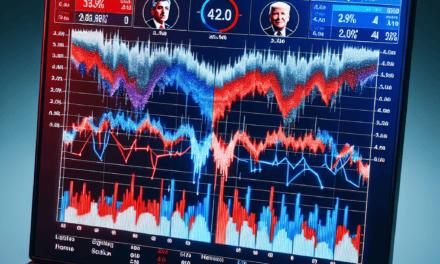“Market Surge: Trump Trade Ignites – Fueling Dollar Dreams and Stock Market Streams”
Introduction
“Market Surge: Trump Trade Ignites from Dollar to Stocks” explores the dynamic shifts in financial markets following significant political developments. The term “Trump Trade” refers to the market reactions and economic policies associated with Donald Trump’s presidency, which have sparked notable movements across various asset classes. This phenomenon has seen the U.S. dollar strengthen, stock markets rally, and investor sentiment shift in response to anticipated regulatory changes, tax reforms, and infrastructure spending. The article delves into the implications of these market trends, analyzing how investor strategies and economic forecasts are being reshaped in the wake of this political and economic landscape.
Impact Of Trump Trade On Global Markets
The phenomenon known as the “Trump Trade” has significantly impacted global markets, creating ripples across various sectors, from currency valuations to stock indices. This term, coined during Donald Trump’s presidency, refers to the market movements and economic expectations triggered by his policies and rhetoric. As investors and analysts closely monitor these developments, the effects of the Trump Trade continue to reverberate, influencing both short-term market dynamics and long-term economic strategies.
Initially, the Trump Trade was characterized by a surge in the U.S. dollar, driven by expectations of fiscal stimulus, tax cuts, and deregulation. These anticipated policies were seen as catalysts for economic growth, prompting investors to flock to dollar-denominated assets. Consequently, the dollar appreciated against a basket of major currencies, affecting global trade balances and capital flows. This appreciation had a dual impact: while it bolstered the purchasing power of American consumers and businesses abroad, it also posed challenges for U.S. exporters by making their goods more expensive in foreign markets.
Simultaneously, the Trump Trade fueled a rally in U.S. stock markets, with major indices such as the Dow Jones Industrial Average and the S&P 500 reaching record highs. Investors were optimistic about the potential for corporate tax cuts and infrastructure spending, which were expected to boost corporate earnings and economic growth. This optimism was further supported by a regulatory environment perceived as more business-friendly, encouraging investment and expansion across various industries. As a result, sectors such as financials, industrials, and energy experienced significant gains, reflecting investor confidence in the administration’s pro-growth agenda.
However, the impact of the Trump Trade was not confined to the United States. Global markets also felt its influence, as changes in U.S. economic policy and market sentiment had far-reaching implications. For instance, emerging markets faced increased volatility due to shifts in capital flows and currency valuations. A stronger dollar often led to capital outflows from these markets, as investors sought higher returns in the U.S. This, in turn, put pressure on emerging market currencies and raised concerns about debt sustainability, given that many of these countries had borrowed heavily in dollars.
Moreover, the Trump Trade affected global trade dynamics, as the administration’s protectionist stance and trade negotiations introduced uncertainty into international markets. Tariffs and trade disputes, particularly with major economies like China, created volatility and disrupted supply chains. Businesses worldwide had to navigate this uncertain landscape, adjusting their strategies to mitigate risks associated with potential trade barriers and retaliatory measures.
In addition to these economic impacts, the Trump Trade also influenced investor sentiment and market psychology. The unpredictability of policy announcements and geopolitical developments under the Trump administration contributed to heightened market volatility. Investors had to remain vigilant, adapting their portfolios to account for rapid changes in market conditions and policy directions.
In conclusion, the Trump Trade has had a profound impact on global markets, shaping currency valuations, stock indices, and trade dynamics. While it has created opportunities for growth and investment, it has also introduced challenges and uncertainties that continue to affect market participants worldwide. As the global economy evolves, understanding the implications of the Trump Trade remains crucial for investors, policymakers, and businesses seeking to navigate this complex and interconnected landscape.
Dollar Strength: A Key Driver In The Trump Trade
The resurgence of the so-called “Trump Trade” has captured the attention of investors and analysts alike, with the U.S. dollar emerging as a pivotal force in this financial phenomenon. The term “Trump Trade” refers to the market movements that were initially observed following the 2016 U.S. presidential election, characterized by a surge in stock prices, a strengthening dollar, and rising bond yields. As the market once again experiences similar dynamics, the role of the dollar as a key driver cannot be overstated.
To understand the current market surge, it is essential to examine the factors contributing to the dollar’s strength. One primary reason is the robust performance of the U.S. economy, which has consistently outpaced many of its global counterparts. Economic indicators such as GDP growth, employment rates, and consumer spending have all shown resilience, bolstering investor confidence in the dollar. Furthermore, the Federal Reserve’s monetary policy has played a significant role. With interest rates remaining relatively high compared to other major economies, the dollar has become an attractive option for investors seeking higher returns.
In addition to domestic factors, global economic conditions have also contributed to the dollar’s appreciation. Uncertainties surrounding geopolitical tensions, trade disputes, and economic slowdowns in other regions have led investors to seek the relative safety of the U.S. currency. This flight to safety has further strengthened the dollar, reinforcing its position as a cornerstone of the Trump Trade.
The impact of a strong dollar extends beyond currency markets, influencing other asset classes such as stocks and bonds. As the dollar appreciates, U.S. equities often benefit from increased foreign investment. International investors, attracted by the potential for higher returns and a stable economic environment, pour capital into American markets, driving up stock prices. This influx of investment not only boosts market indices but also enhances the overall sentiment, creating a positive feedback loop that perpetuates the market surge.
Moreover, the dollar’s strength has implications for multinational corporations. While a stronger dollar can pose challenges for companies with significant overseas revenues, it also reduces the cost of importing goods and services. This dynamic can lead to improved profit margins for certain sectors, particularly those reliant on foreign inputs. Consequently, investors may adjust their portfolios to capitalize on these opportunities, further fueling the Trump Trade.
However, it is important to recognize that the dollar’s strength is not without its challenges. For emerging markets, a robust dollar can exacerbate existing vulnerabilities, as many of these economies rely on dollar-denominated debt. As the dollar appreciates, the cost of servicing this debt increases, potentially leading to financial instability. This dynamic underscores the interconnectedness of global markets and highlights the need for investors to remain vigilant.
In conclusion, the dollar’s strength is undeniably a key driver in the resurgence of the Trump Trade. Its influence permeates various aspects of the financial markets, from equities to bonds, shaping investment strategies and market sentiment. As investors navigate this complex landscape, understanding the factors underpinning the dollar’s appreciation will be crucial in making informed decisions. While the current market surge presents opportunities, it also demands careful consideration of the broader economic context and potential risks.
Stock Market Rally: Analyzing The Trump Effect
The recent surge in the stock market, often referred to as the “Trump Trade,” has captured the attention of investors and analysts alike. This phenomenon, characterized by a significant uptick in stock prices and a strengthening of the U.S. dollar, can be attributed to a confluence of factors associated with the economic policies and political climate under the Trump administration. To understand the dynamics of this market rally, it is essential to examine the underlying elements that have contributed to this financial upswing.
Initially, the anticipation of pro-business policies played a pivotal role in igniting investor optimism. The Trump administration’s promises of tax cuts, deregulation, and infrastructure spending created a favorable environment for businesses, leading to increased corporate earnings expectations. As a result, investors flocked to the stock market, driving up prices across various sectors. This optimism was further bolstered by the administration’s focus on reducing corporate tax rates, which was perceived as a catalyst for economic growth and increased profitability for companies.
Moreover, the Trump administration’s stance on deregulation provided an additional boost to market sentiment. By rolling back regulations in industries such as energy, finance, and manufacturing, the administration aimed to reduce operational costs and enhance competitiveness. This deregulatory approach was particularly appealing to investors, as it signaled a more business-friendly environment that could potentially lead to higher returns on investment. Consequently, sectors that were previously burdened by stringent regulations experienced a resurgence, contributing to the overall market rally.
In addition to domestic policies, the global economic landscape also played a significant role in the market surge. The strengthening of the U.S. dollar, often seen as a barometer of economic confidence, was influenced by the administration’s trade policies and geopolitical strategies. The emphasis on renegotiating trade agreements and imposing tariffs on certain imports was intended to protect domestic industries and promote fair trade practices. While these measures were met with mixed reactions, they ultimately contributed to a perception of economic resilience, further fueling the appreciation of the dollar.
Furthermore, the Federal Reserve’s monetary policy decisions during this period cannot be overlooked. The central bank’s gradual approach to raising interest rates, in response to a strengthening economy, provided a stable backdrop for the stock market rally. Higher interest rates typically signal confidence in economic growth, encouraging investment in equities. This monetary policy stance, coupled with fiscal measures, created a conducive environment for the continuation of the market surge.
However, it is important to acknowledge the inherent risks and uncertainties associated with the Trump Trade. While the initial market response was overwhelmingly positive, concerns about potential trade wars, geopolitical tensions, and the sustainability of economic growth remain prevalent. Investors must remain vigilant and consider these factors when making investment decisions, as market conditions can change rapidly in response to evolving political and economic developments.
In conclusion, the Trump Trade has been a multifaceted phenomenon, driven by a combination of domestic policies, global economic factors, and monetary policy decisions. The stock market rally, characterized by rising stock prices and a stronger dollar, reflects investor optimism in response to the administration’s economic agenda. However, as with any market trend, it is crucial for investors to remain informed and adaptable, recognizing the potential challenges and opportunities that lie ahead.
Sector Winners And Losers In The Trump Trade Surge
The recent market surge, often referred to as the “Trump Trade,” has sparked significant interest and debate among investors and analysts alike. This phenomenon, characterized by a notable rise in the U.S. dollar and stock markets, has led to a reshuffling of sector winners and losers. As we delve into the intricacies of this market movement, it is essential to understand the underlying factors driving these changes and their implications for various sectors.
To begin with, the financial sector has emerged as a clear winner in the Trump Trade surge. The anticipation of deregulation and potential tax reforms has fueled optimism among investors, leading to a rally in bank stocks. Financial institutions are expected to benefit from a more favorable regulatory environment, which could enhance profitability and growth prospects. Moreover, the prospect of rising interest rates, often associated with economic expansion, has further bolstered the sector, as higher rates typically translate into increased net interest margins for banks.
In contrast, the technology sector has experienced mixed outcomes during this market shift. While some tech giants have continued to thrive due to their robust business models and global reach, others have faced headwinds. Concerns over potential trade policies and regulatory scrutiny have created uncertainty for companies heavily reliant on international markets. Nevertheless, the sector’s inherent innovation and adaptability have allowed many firms to navigate these challenges, maintaining their competitive edge.
Transitioning to the industrial sector, the Trump Trade has brought about a resurgence of interest. Infrastructure spending promises and a focus on domestic manufacturing have provided a boost to companies within this space. The anticipation of increased government investment in infrastructure projects has led to heightened demand for construction materials and machinery, benefiting firms involved in these industries. However, it is crucial to note that the realization of these promises remains contingent on policy implementation, which introduces an element of uncertainty.
Meanwhile, the energy sector has also experienced a notable impact from the Trump Trade. The administration’s stance on energy independence and support for fossil fuels has been a boon for traditional energy companies. The potential for reduced regulatory burdens and increased domestic production has led to a positive outlook for oil and gas firms. However, this shift has also raised concerns about the future of renewable energy initiatives, as policy priorities may shift away from sustainable energy sources.
On the other hand, the healthcare sector has faced challenges amid the market surge. Uncertainty surrounding healthcare policy and potential changes to the Affordable Care Act have created volatility for companies within this industry. Investors remain cautious as they assess the potential implications of policy shifts on healthcare providers, insurers, and pharmaceutical companies. Despite these challenges, the sector’s long-term growth prospects, driven by an aging population and technological advancements, continue to offer opportunities for investors.
In conclusion, the Trump Trade surge has led to a dynamic reshaping of sector winners and losers, driven by a complex interplay of policy expectations and market sentiment. While some sectors have thrived under the promise of deregulation and economic growth, others have faced uncertainty and challenges. As investors navigate this evolving landscape, it is essential to remain vigilant and adaptable, recognizing that market conditions can shift rapidly in response to policy developments and global economic trends. Ultimately, understanding the nuances of each sector’s response to the Trump Trade will be crucial for making informed investment decisions in this ever-changing environment.
Investor Sentiment: How Trump Policies Influence Markets
Investor sentiment plays a crucial role in shaping market dynamics, and the influence of political figures on this sentiment cannot be overstated. The Trump era, characterized by its distinctive economic policies and rhetoric, has had a profound impact on financial markets, from the strength of the dollar to the performance of stocks. Understanding how these policies influence markets requires a closer examination of the mechanisms through which investor sentiment is affected.
Initially, the Trump administration’s approach to economic policy was marked by a focus on deregulation, tax cuts, and a robust stance on trade. These policies were designed to stimulate economic growth and were generally well-received by investors, who anticipated a more business-friendly environment. The promise of tax reform, in particular, was a significant driver of optimism, as it was expected to increase corporate profits and, consequently, shareholder returns. This optimism was reflected in the stock market, which experienced a notable surge as investors adjusted their expectations in line with the anticipated benefits of these policies.
Moreover, the administration’s emphasis on deregulation was seen as a boon for industries that had long been burdened by stringent regulatory frameworks. By reducing the regulatory load, companies could potentially lower their operational costs and increase profitability. This prospect further fueled investor confidence, contributing to the upward momentum in stock prices. The financial sector, in particular, stood to gain from deregulation, as it promised greater flexibility and reduced compliance costs.
In addition to domestic policies, the Trump administration’s approach to international trade also played a significant role in shaping market sentiment. The administration’s protectionist stance, characterized by the imposition of tariffs and renegotiation of trade agreements, introduced a degree of uncertainty into global markets. While some investors viewed these measures as a means to protect domestic industries and promote fair trade, others were concerned about the potential for trade wars and their impact on global economic growth. This dichotomy in investor sentiment led to periods of volatility, as markets reacted to the evolving trade landscape.
The strength of the U.S. dollar during this period can also be attributed, in part, to the administration’s policies. The combination of tax cuts and increased government spending raised expectations of higher interest rates, which, in turn, bolstered the dollar. A stronger dollar, while beneficial for importers and consumers, posed challenges for exporters and multinational companies, as it made U.S. goods more expensive on the global market. This dynamic added another layer of complexity to investor sentiment, as market participants weighed the benefits of a strong domestic economy against the potential drawbacks of a robust currency.
In conclusion, the Trump administration’s policies had a multifaceted impact on investor sentiment, influencing markets in various ways. The promise of tax cuts and deregulation fostered optimism and drove stock prices higher, while the administration’s trade policies introduced elements of uncertainty and volatility. The strength of the dollar, influenced by expectations of higher interest rates, further complicated the investment landscape. As investors navigated these dynamics, their sentiment was shaped by a complex interplay of domestic and international factors, underscoring the profound influence of political leadership on financial markets. Understanding these influences is essential for investors seeking to make informed decisions in an ever-evolving economic environment.
Comparing Pre- And Post-Trump Market Dynamics
The financial markets have always been a reflection of political climates, and the Trump era was no exception. The period before and after Donald Trump’s presidency marked significant shifts in market dynamics, with notable changes in investor sentiment, policy impacts, and economic indicators. To understand these shifts, it is essential to compare the pre-Trump and post-Trump market environments, focusing on the dollar’s performance, stock market trends, and broader economic implications.
Before Trump’s presidency, the market was characterized by a relatively stable economic environment under the Obama administration. The U.S. dollar, while strong, did not experience the same volatility that would later become a hallmark of the Trump years. Investors were primarily focused on the Federal Reserve’s monetary policy, which was gradually moving away from the quantitative easing measures implemented during the financial crisis. The stock market, meanwhile, was on a steady upward trajectory, buoyed by improving economic indicators and corporate earnings.
However, the election of Donald Trump in 2016 marked a turning point. His administration’s policies, particularly those related to tax reform, deregulation, and trade, had profound effects on market dynamics. The Tax Cuts and Jobs Act of 2017, for instance, significantly reduced corporate tax rates, leading to a surge in corporate profits and stock buybacks. This, in turn, fueled a bull market, with major indices like the S&P 500 and Dow Jones Industrial Average reaching record highs. The promise of deregulation also boosted investor confidence, particularly in sectors such as energy and finance.
In contrast, the dollar’s performance during the Trump era was more complex. Initially, the dollar strengthened on expectations of fiscal stimulus and higher interest rates. However, as trade tensions escalated, particularly with China, the dollar experienced periods of volatility. The imposition of tariffs and the uncertainty surrounding trade negotiations created fluctuations in currency markets, reflecting broader concerns about global economic stability.
Transitioning to the post-Trump period, the market dynamics shifted once again. The Biden administration’s focus on infrastructure spending, renewable energy, and social programs introduced new variables into the economic equation. While the stock market continued to perform well, driven by sectors like technology and healthcare, there was a renewed emphasis on sustainable and socially responsible investing. The dollar, meanwhile, faced downward pressure as the Federal Reserve maintained a dovish stance to support economic recovery amid the COVID-19 pandemic.
Moreover, the post-Trump era has been marked by heightened attention to global issues such as climate change and geopolitical tensions. These factors have influenced market dynamics, as investors increasingly consider environmental, social, and governance (ESG) criteria in their decision-making processes. The shift towards a more globally integrated and sustainable economic model has introduced new opportunities and challenges for market participants.
In conclusion, the comparison of pre- and post-Trump market dynamics reveals a complex interplay of political, economic, and social factors. While the Trump era was characterized by significant market surges driven by tax cuts and deregulation, it also introduced volatility through trade policies and geopolitical tensions. The post-Trump period, on the other hand, has seen a continuation of market growth, albeit with a greater focus on sustainability and global cooperation. As investors navigate this evolving landscape, understanding these dynamics is crucial for making informed decisions in an increasingly interconnected world.
Long-term Implications Of The Trump Trade On The Economy
The phenomenon known as the “Trump Trade” has been a subject of considerable interest and debate among economists and market analysts since its inception. This term refers to the market surge that followed the election of Donald Trump as the President of the United States in 2016, characterized by a significant rise in stock prices, a strengthening of the U.S. dollar, and increased investor optimism. As we delve into the long-term implications of the Trump Trade on the economy, it is essential to consider both the immediate effects and the enduring consequences that have unfolded over the years.
Initially, the Trump Trade was driven by expectations of pro-business policies, including tax cuts, deregulation, and infrastructure spending. These anticipated measures fueled investor confidence, leading to a bullish stock market and a robust dollar. The immediate impact was a surge in equity prices, particularly in sectors such as financials, industrials, and energy, which were expected to benefit most from the proposed policy changes. Moreover, the promise of tax reform and deregulation was seen as a catalyst for economic growth, prompting businesses to increase capital expenditures and expand operations.
However, as time progressed, the long-term implications of the Trump Trade began to manifest in more complex ways. One significant aspect was the impact on international trade relations. The administration’s protectionist stance, characterized by tariffs and renegotiation of trade agreements, introduced a level of uncertainty that affected global supply chains and international markets. While some domestic industries benefited from protective measures, others faced challenges due to retaliatory tariffs and disrupted trade flows. This shift in trade dynamics had a ripple effect on the global economy, influencing investment decisions and altering competitive landscapes.
Furthermore, the fiscal policies associated with the Trump Trade, particularly the Tax Cuts and Jobs Act of 2017, had profound implications for the U.S. economy. While the tax cuts provided a short-term boost to corporate profits and consumer spending, they also contributed to a significant increase in the federal deficit. The long-term sustainability of such fiscal policies remains a topic of concern, as rising debt levels could constrain future government spending and investment in critical areas such as infrastructure and education.
In addition to fiscal and trade policies, the Trump Trade also had implications for monetary policy. The initial market surge and economic optimism led to expectations of higher inflation and interest rates. Consequently, the Federal Reserve adopted a more hawkish stance, gradually raising interest rates to prevent the economy from overheating. This shift in monetary policy had implications for borrowing costs, consumer spending, and investment decisions, influencing the broader economic landscape.
As we consider the long-term implications of the Trump Trade, it is crucial to recognize the interplay between policy decisions, market reactions, and economic outcomes. While the initial surge in markets reflected optimism about potential policy changes, the subsequent years have highlighted the complexities and challenges associated with implementing and sustaining such policies. The Trump Trade has underscored the importance of balancing short-term gains with long-term economic stability, as well as the need for coherent and consistent policy frameworks that can adapt to evolving global dynamics.
In conclusion, the Trump Trade has left an indelible mark on the economy, shaping market trends and influencing policy debates. Its long-term implications continue to unfold, offering valuable lessons for policymakers, investors, and economists alike. As we navigate the future, understanding the legacy of the Trump Trade will be essential in crafting strategies that promote sustainable economic growth and resilience in an ever-changing global landscape.
Q&A
1. **What is the “Trump Trade”?**
– The “Trump Trade” refers to the market movements and investment strategies that emerged following Donald Trump’s election as President of the United States in 2016, characterized by expectations of tax cuts, deregulation, and infrastructure spending.
2. **How did the dollar react to the Trump Trade?**
– The dollar surged as investors anticipated stronger economic growth and higher interest rates under Trump’s policies, leading to increased demand for the currency.
3. **What was the impact on U.S. stocks?**
– U.S. stocks, particularly in sectors like financials and industrials, experienced significant gains as investors bet on economic growth and corporate tax cuts.
4. **How did bond markets respond?**
– Bond markets saw a sell-off, leading to rising yields, as investors expected higher inflation and interest rates due to anticipated fiscal stimulus.
5. **What sectors benefited the most from the Trump Trade?**
– Financials, industrials, and materials sectors benefited the most, driven by expectations of deregulation, infrastructure spending, and tax reforms.
6. **How did international markets react?**
– International markets had mixed reactions; some emerging markets faced pressure due to a stronger dollar, while others benefited from increased U.S. demand.
7. **What were the long-term expectations of the Trump Trade?**
– Long-term expectations included sustained economic growth, higher corporate profits, and potential shifts in global trade dynamics, though these were subject to political and economic uncertainties.
Conclusion
The “Market Surge: Trump Trade Ignites from Dollar to Stocks” highlights a significant financial market reaction following political developments associated with Donald Trump. This surge is characterized by a notable increase in the value of the U.S. dollar and a rally in stock markets, driven by investor optimism about potential economic policies such as tax cuts, deregulation, and infrastructure spending. These anticipated policies are expected to stimulate economic growth, boost corporate profits, and enhance market confidence. However, the surge also brings potential risks, including increased volatility and uncertainty regarding the long-term impacts of such policies on the economy and global trade relations. Overall, the market’s response underscores the profound influence of political events on financial markets and the importance of investor sentiment in driving market dynamics.





